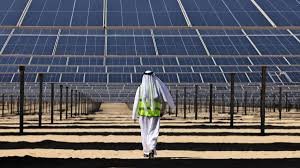The Middle East, known for its vast oil reserves, is now making headlines for a different reason. It has become the world’s fastest-growing market for renewable energy, second only to China. Countries in the region are investing heavily in solar, wind, and other green energy sources, shifting away from their long-standing dependence on fossil fuels.
A Rapid Shift to Renewable Energy
For years, the Middle East has relied on oil and gas exports to power its economy. However, as global demand for clean energy rises and oil prices fluctuate, many countries in the region are looking for alternatives. Governments are now investing billions of dollars into solar and wind power, aiming to diversify their energy sources and reduce carbon emissions.

The United Arab Emirates (UAE) and Saudi Arabia are leading the way with ambitious projects. The UAE’s Noor Abu Dhabi solar plant is one of the largest in the world, while Saudi Arabia’s Vision 2030 plan includes massive investments in wind and solar farms. Other countries, including Oman, Qatar, and Egypt, are also stepping up their efforts to increase their share of renewable energy.

Why the Middle East Is Investing in Green Energy
Several factors are driving this shift toward renewables:
- Abundant Sunlight and Wind: The Middle East has one of the highest solar radiation levels in the world, making it ideal for solar energy projects. Some areas also experience strong winds, perfect for wind power.
- Lower Costs: The cost of producing solar and wind energy has dropped significantly in recent years, making renewables more attractive and profitable.
- Reducing Carbon Footprint: Many governments are committing to international climate goals and seeking to lower their greenhouse gas emissions.
- Economic Diversification: Oil-rich nations want to reduce their dependence on fossil fuels and create new job opportunities in the renewable energy sector.
- Energy Security: Relying on renewables allows countries to meet domestic energy needs without depending heavily on oil exports.
Record-Breaking Renewable Projects
The Middle East is home to some of the world’s most ambitious renewable energy projects. The UAE’s Mohammed bin Rashid Al Maktoum Solar Park is one of the largest solar parks globally, with a goal of producing 5,000 megawatts (MW) by 2030. Similarly, Saudi Arabia’s NEOM city project includes plans for the world’s largest green hydrogen plant, a major step in clean energy production.
In Egypt, the Benban Solar Park has put the country on the renewable energy map. Spanning 37 square kilometers, this massive solar farm is one of the biggest in Africa and a key part of Egypt’s plan to produce 42% of its electricity from renewables by 2035.
Challenges in the Path to Clean Energy
Despite the rapid progress, the Middle East faces some challenges in its transition to renewable energy:
- Initial Investment Costs: While costs have fallen, building large-scale renewable projects still requires significant upfront investment.
- Infrastructure Needs: Many countries need to upgrade their power grids to support a higher share of renewable energy.
- Oil Industry Resistance: The shift to clean energy may face pushback from those who benefit from the region’s strong oil and gas sector.
- Storage and Reliability: Renewable energy depends on weather conditions, so countries must invest in energy storage technologies to ensure a stable supply.
The Future of Renewables in the Middle East
The region’s rapid adoption of renewable energy shows no signs of slowing down. Governments are introducing policies and incentives to attract more investment in the sector. Experts predict that by 2050, renewables could supply a significant portion of the Middle East’s energy needs.
As the world moves towards a greener future, the Middle East’s transformation into a leader in renewable energy marks a major shift. Once known only for oil, the region is proving that it can adapt and thrive in a changing energy landscape.
Also read: UAE to Invest $40 Billion in Italy – A Game-Changer for Both Nations













